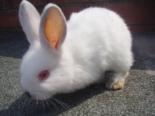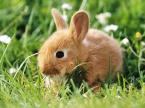|
Did You Know New Zealand Rabbits Originated In America?
It's true; New Zealand Rabbits are an American rabbit. In 1912 the first New Zealand rabbit was a red colored variety then in 1916 the first litter of white rabbits was introduced. The red variety is thought to be a cross between a Belgian hare and a white rabbit. The white breed is also a crossbreed of the Flemish, American Whites and Angoras. The Black variety is a cross between different varieties which included the Giant Chinchilla. The white rabbits have distinctive bright eyes in a pale pink or ruby red color. They were bred for their meat and fur but their easy and sweet temperaments made them a quick favorite as a domestic rabbit. They are excellent show rabbits also.
Since rabbits react similar as human do to medications and diseases, these poor rabbits are used in labs for tests developments and drug testing for diseases such as diabetes, diphtheria, tuberculosis, cancer and heart disease. Skin cream, cosmetics, special diets and food additives have also been tested on the white New Zealand rabbits. The body on these rabbits are well-rounded, with slender and muscular faces; round cheeks and large hind legs and short front feet. Their ears are long and stand up straight. Their body fur is thick but the fur on their ears is shorter which allows the pink of their skin to show through. The Bucks (males) weight approximately 8-10 pounds and the Does (females) weigh 9-12 pounds. The females also have a dewlap which is a flap of fur below the chin that is pulled for a nesting box during pregnancies.
The owners claim their rabbit grew too big. Some people are also squeamish about their eye color. The rabbit’s pinkish or ruby red eyes don’t appeal to some people so these rabbits find themselves unadoptable. That’s a shame because these rabbits are very social that love to be handled and would make a great addition to any rabbit-lover’s family.
If housed outdoors, here are some tips to keep your pet safe.
You should remember that each rabbit has their own personality. Even though these rabbits are known to have a good temperament and get along with other pets. You need to make sure you and the rabbit are compatible before adopting or buying. Rabbits live a long time, 7-10 years, so you are making a commitment with this little creature. DIET
The diet is the same as other breeds; a good quality pellet with unlimited hay. I always like Timothy Hay as the loose hay and I give Oreo Alfalfa hay in a pressed-cube form. Don’t forget about daily exercise and a New Zealand rabbit will need plenty of exercise, especially if you keep him in a cage. He will also need fresh water daily.
Do's and Don'ts when it comes to feeding your rabbit
A female (Doe) is fertile all year long. The gestation period is normally 28-31 days. A few days before giving birth, the doe will make her nesting box. She will pull fur from her dewlap, hay and any other material to make her nesting box. Her babies (Kittens) are born hairless and within 5 or 6 days their fur begins to grow. The kittens will start to open their eyes 10-12 days after birth. When the babies are 3 months old they will start to eat the rabbit pellets and hay. They will be weaned off their mother’s milk. The average litter has 6 babies but litters can range from 2 to 12. Since female rabbits are very fertile, a doe can become pregnant again soon after giving birth.
|







